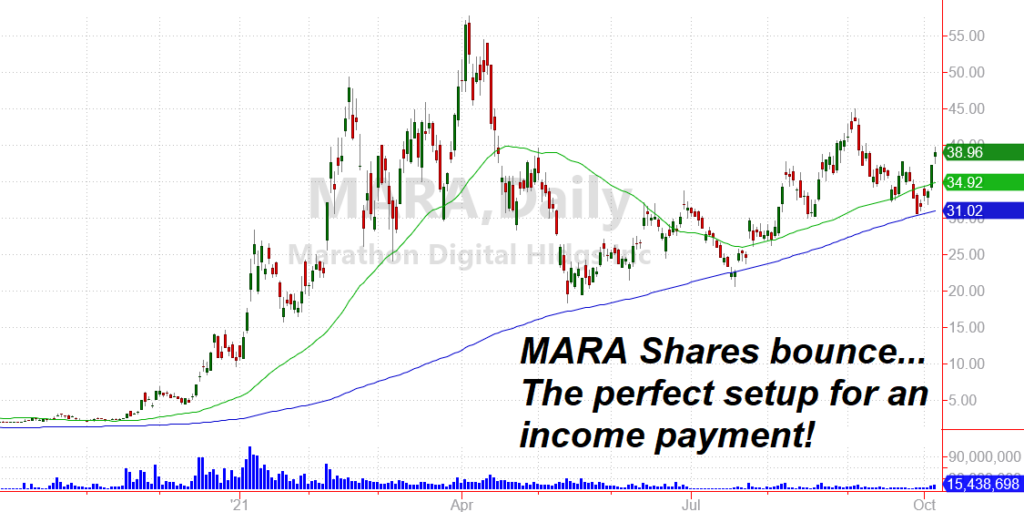
[Editor’s Note: This is part V of our series on investment income plays selling put contracts.
- In Part I we talked about put contracts and how to sell them for income.
- Part II covered how to find the best income plays.
- In Part III we covered how much income you can really make.
- And in Part IV we talked about how this strategy holds up in a bear market.
Today, I want to explain “the catch” behind this strategy. In other words, we’ll cover what you’re giving up to book reliable income from this strategy.]
“There’s no such thing as a free lunch…“
At least that’s what my mom told us as kids. (Typically the statement came right before she pulled out her list of chores for us.)
The statement is usually true with your investments as well. There’s no “free money” in the market. And for the most part, when you hear about strategy or approach that has a special advantage, there’s always a catch.
Even our income strategy that I love so much comes with a price.
Once you understand what you have to give up to collect our income payments, you might decide this strategy isn’t for you.
Or you may agree with me… (I think the income we get from this approach is well worth the price of admission.)
Either way, I want to make sure you’re fully informed before you decide to use this income approach in your own account.
Playing “A-B-C” Baseball
To understand the “catch” behind this income strategy, it helps to use a baseball analogy.
There are baseball teams known for their power hitters. And fans love to go to the ballpark and watch these hitters knock the long-ball out of the park.
On the other end of the spectrum, teams that play “A-B-C” baseball start by getting a runner on base. Then, the next hitter may sacrifice to move him over to second or third base. These teams “manufacture” runs by doing small things right and putting probabilities in their favor.
Power teams win huge games in dramatic fashion when the big hitters connect.
But fundamental teams consistently score runs and usually wind up with a chance to make the playoffs at the end of a season.
As you might have guessed, our income strategy is a lot like the fundamental baseball team.
When you sell a put contract, you’re stepping up to the plate and trying to hit a single or a double. The most you can possibly make is the income you receive from selling your put contract.
So you’re never going to shoot the lights out with any single trade.
Let’s take a look at a recent example.
Always a Catch: MARA Example
Last month I used our income strategy to collect a payment from shares of Marathon Digital (MARA). The company is a cryptocurrency miner and with Bitcoin moving back towards all-time highs, the company’s outlook was strong. Plus, the stock bounced off a key support line (see chart below).

The chart above shows what MARA looked like on October 6th. On that day I sold two MARA put contracts. These contracts had a November 19th expiration date and a $35 strike price. So by selling these shares, I was agreeing to buy MARA at $35 — and my agreement was set to last until November 19th.
I received $3.43 per share for entering this agreement. So with two contracts (each representing 100 shares) my total income was $686 (less commissions).
Given the strong backdrop for the company (with Bitcoin prices rising) I would have been happy to buy shares of MARA at $35. And I was pleased with the $686 of income I received from this trade.
Now, let’s take a look at where MARA stands today…

As you can see, shares of MARA surged higher. Anyone who bought shares of MARA on the day I sold my put contracts could have ultimately made about $25 per share.
I ultimately closed out my trade, buying the puts back at $0.70 and locking in a gain of $2.73 per share — or about $545 for the two contracts. And while I was happy with the income, I didn’t hit a “home run” with MARA.
Balancing Reliability And Big Wins
So is this income approach the BEST way to invest? Or is it better to swing for the fences and lock in bigger profits?
I don’t think there’s necessarily a right or a wrong answer here. And you don’t necessarily have to choose between the two!
(I actually keep an account that I use for aggressive / speculative trades, and another account that I use for generating income with my favorite put-selling approach).
The important take-away from today’s message is that there’s always a catch when it comes to different strategies. You have to give up one thing in order to get something else.
In this case, our income strategy is reliable and can cut down on your investment risk. But it also gives up the potential for much bigger profits if your stock shoots higher.
Understanding the whole picture — including both the advantages and disadvantages — gives you a chance to make an informed decision about whether this approach is right for you.
We’ll keep covering more details about this approach and how to use it in your own brokerage account.
In the meantime, please let me know if you have questions! You can leave a comment below and I’ll do my best to clarify anything I need to in future alerts.
Here’s to generating reliable income from your favorite stocks!
